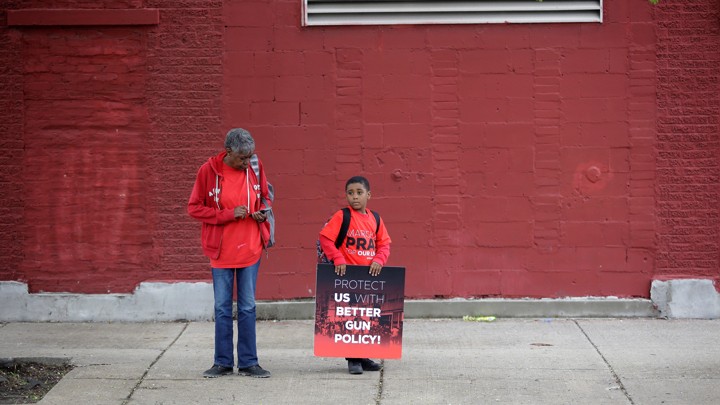The Normalization of Gun Violence in Poor Communities
Krishnadev
Calamur, The Atlantic, Jun 24, 2018
A company
that uses sensors to recognize the sound of gunshots could help solve the
epidemic.
that uses sensors to recognize the sound of gunshots could help solve the
epidemic.
 |
| A boy holds a sign before a march against gun violence in Chicago on May 19, 2018. Joshua Lott / Reuters |
Ralph A.
Clark remembers the first time he went for a ride-along with police. He was in
Baltimore, and a teenager had been killed. He says what shocked him was not the
sight of the body on the street, but the lack of reaction from people at the
scene—“as if nothing had happened.”
“That is
the cost of gun violence,” Clark, who is the president and CEO of ShotSpotter,
a company whose technology uses sensors to identify the sound of a gun being
fired, said Friday at the Aspen Ideas Festival, which is cohosted by The Aspen
Institute and The Atlantic.
the cost of gun violence,” Clark, who is the president and CEO of ShotSpotter,
a company whose technology uses sensors to identify the sound of a gun being
fired, said Friday at the Aspen Ideas Festival, which is cohosted by The Aspen
Institute and The Atlantic.
Clark
noted that although much of the focus on gun violence in the U.S. is on mass
shootings, they account for about 1 percent of all shooting deaths. The
overwhelming majority of gun crimes are committed with illegally obtained
firearms. Not only that: very few individuals are responsible for most of those
gun crimes, he said. But the vast majority of persistent, ongoing gun violence
goes unreported by residents who live in communities that are often poor and
under-served by police.
noted that although much of the focus on gun violence in the U.S. is on mass
shootings, they account for about 1 percent of all shooting deaths. The
overwhelming majority of gun crimes are committed with illegally obtained
firearms. Not only that: very few individuals are responsible for most of those
gun crimes, he said. But the vast majority of persistent, ongoing gun violence
goes unreported by residents who live in communities that are often poor and
under-served by police.
“Eighty
to 90 percent of the time a gun is fired, there’s no call to 911,” Clark said,
“which means there’s no police response, which means that gun violence becomes
normalized in these communities.”
to 90 percent of the time a gun is fired, there’s no call to 911,” Clark said,
“which means there’s no police response, which means that gun violence becomes
normalized in these communities.”
Clark’s
company’s technology is used in 100 U.S. cities, as well as in Cape Town, South
Africa. It costs cities an annual subscription of between $65,000 and $85,000
per square mile per year. Smaller cities can get the service for about
$200,000, but for larger ones like Chicago, which uses ShotSpotter to track
gunfire across 100 square miles, the cost is about $5 million annually. The
price is worth it, Clark said, because “the downstream consequences of what it
means to be traumatized” are far higher.
company’s technology is used in 100 U.S. cities, as well as in Cape Town, South
Africa. It costs cities an annual subscription of between $65,000 and $85,000
per square mile per year. Smaller cities can get the service for about
$200,000, but for larger ones like Chicago, which uses ShotSpotter to track
gunfire across 100 square miles, the cost is about $5 million annually. The
price is worth it, Clark said, because “the downstream consequences of what it
means to be traumatized” are far higher.
“If you
realized that there was a child that had to go to bed to the sound of gunfire,
wake up to the sound of gunfire, maybe walk across yellow tape on the way to
school, I think we would think about this issue very differently,” he said.
realized that there was a child that had to go to bed to the sound of gunfire,
wake up to the sound of gunfire, maybe walk across yellow tape on the way to
school, I think we would think about this issue very differently,” he said.
ShotSpotter’s
technology provides police departments with a comprehensive picture of firearms
use in a community—and it has
been used by prosecutors to convict suspected shooters. Clark
himself says, though, that the technology helps answer a basic question: Is a
community deserving of a police response?
technology provides police departments with a comprehensive picture of firearms
use in a community—and it has
been used by prosecutors to convict suspected shooters. Clark
himself says, though, that the technology helps answer a basic question: Is a
community deserving of a police response?
It’s a
“signal to an at-risk community that they matter, because the thing that we all
know is that when a gun is fired in a nice neighborhood there’s no question
about response. So we’re trying to make sure there’s an aspect of public safety
equity in these under-served communities.”
“signal to an at-risk community that they matter, because the thing that we all
know is that when a gun is fired in a nice neighborhood there’s no question
about response. So we’re trying to make sure there’s an aspect of public safety
equity in these under-served communities.”


